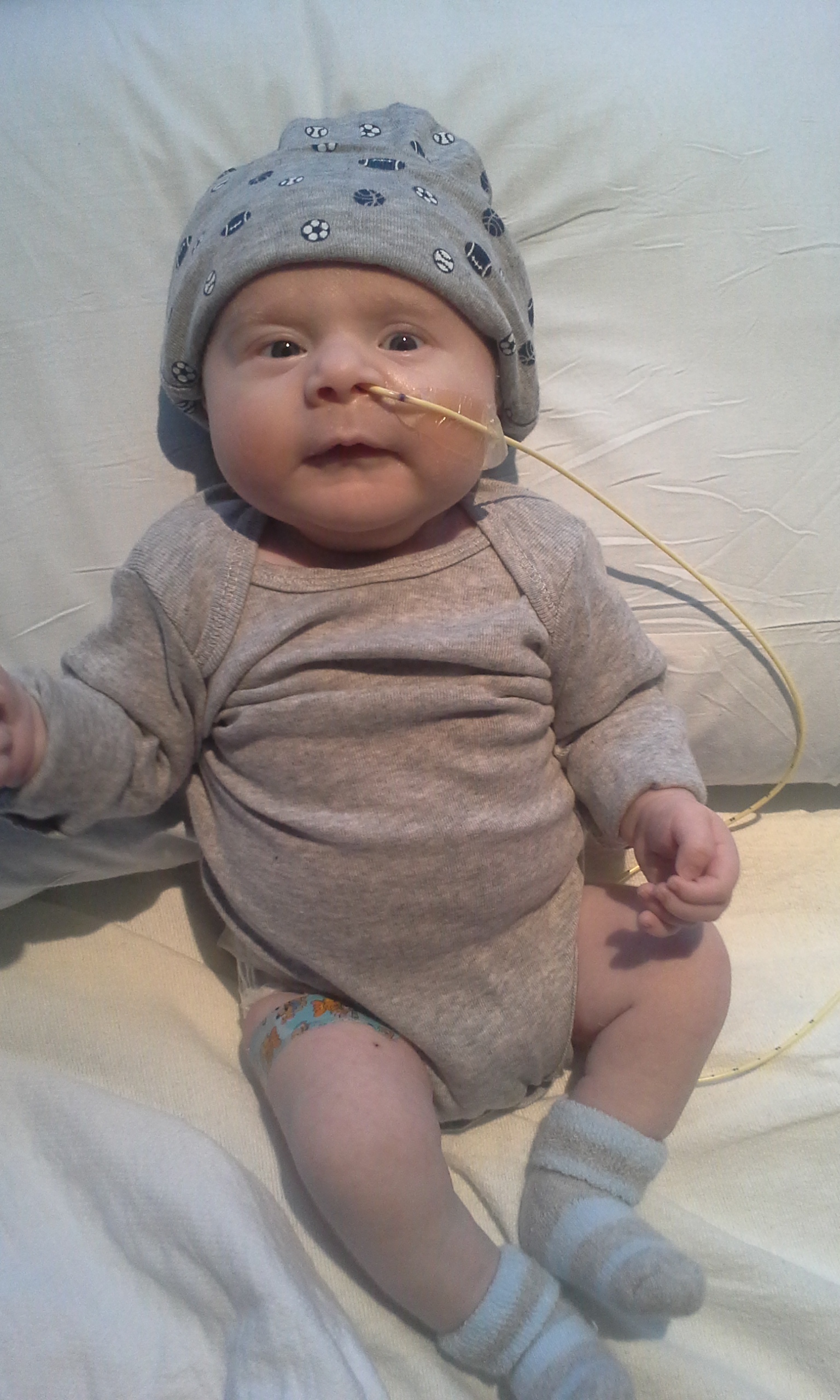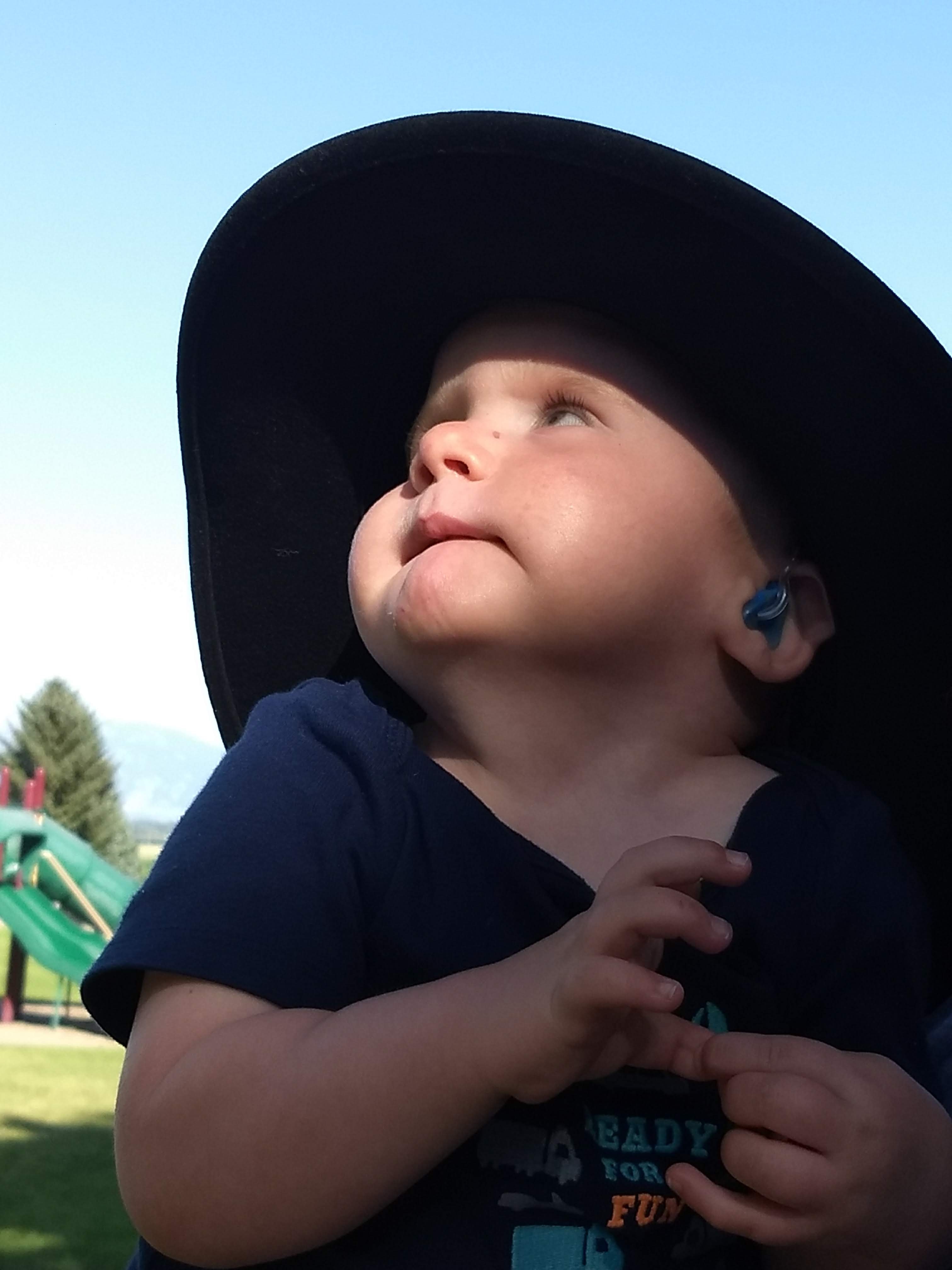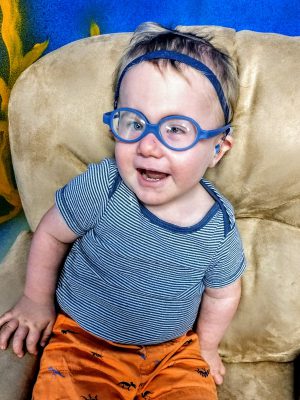Last New Year’s Eve, Elaine Casey’s seventh child was born at home. Her previous home births were complication-free, so there was no reason to expect anything different this time. But when little Caleb was born, he didn’t cry. Instead he made grunting noises, trying to keep his airway open. In eight degrees below zero, mother and baby were transferred by ambulance to the Bozeman hospital. A day later, they were life-flighted to Seattle for open heart surgery. It took several months to receive a diagnosis of CHARGE, a syndrome that affects multiple areas of development. Now a sturdy, determined 20-month-old, Caleb Casey continues to defy expectations.
Case in point: Seattle doctors told Caleb’s parents he is blind. “He sees,” Elaine says. “It’s kind of a miracle. It’s probably blurry for him, but he can see something 10 feet away and go right to it.”
These days, Caleb gets to objects of interest with the help of a gait trainer from MonTECH’s adaptive equipment program, MAEP. Due to DPHHS cuts last fall, MAEP lost its funding. While Program Director Anna-Margaret Goldman was able to incorporate 200 pieces of MAEP equipment into MonTECH’s other programs, she dispersed the remainder to agencies that would allow families continued access. Mosaic Rehabilitation in Belgrade accepted responsibility for some of the inventory, and it was through Mosaic that the Caseys were able to borrow a gait trainer for Caleb.
“Usually, around the house, Caleb would push a little step stool around the kitchen,” Mom Elaine explains. “He adopted that as a little walker. Then we got the walker from MonTECH through Mosaic. He started using the walker, and he wasn’t a baby anymore! He was a toddler! I said, ‘Yay! This is what he’s supposed to be doing!’”
 Caleb is extremely social. Now that he is able to walk independently of others, with the assistance of his walker, he takes advantage of opportunities to visit with, well, anyone. “He loves people,” Elaine says. “Strangers. He’ll glom on to them.” She notes Caleb’s independence from a stroller, or a parent’s arms, has encouraged further development. “When any of his siblings try to direct him or guide the walker, he does what any other kid would do,” she explains. “Like, ‘Eh! Get away!’ Just good, natural-development things!”
Caleb is extremely social. Now that he is able to walk independently of others, with the assistance of his walker, he takes advantage of opportunities to visit with, well, anyone. “He loves people,” Elaine says. “Strangers. He’ll glom on to them.” She notes Caleb’s independence from a stroller, or a parent’s arms, has encouraged further development. “When any of his siblings try to direct him or guide the walker, he does what any other kid would do,” she explains. “Like, ‘Eh! Get away!’ Just good, natural-development things!”
Caleb faces a number of challenges. His vision is affected by colobomas on the backs of his eyes. He has mild hearing loss in his right ear, and profound hearing loss in his left. And it may be three or four years before he will walk without the help of a walker, given the way CHARGE affects his vestibular system. But he has an impressive support team.
In addition to the speech, occupational, and physical therapists at Mosaic, Caleb works with a vision instructor through the Montana School for the Deaf & Blind, an orientation and mobility specialist through Montana Independent Living Project, and an Intervener connected with the family through the Montana Deaf-Blind Project at the Rural Institute for Inclusive Communities. “A lot of people have helped me,” Elaine emphasizes. “The CHARGE web site has advice and strategies for professionals who work with children with CHARGE as well, and that’s been helpful too. Because they don’t work with a lot of kids with this diagnosis.”
Naturally, the team members who are most involved and invested in Caleb’s success are his  family. Grandparents, aunts, and especially, siblings cheer Caleb’s achievements. His brothers and sisters are home-schooled, and take turns attending therapy appointments with Caleb. “We’ve done a lot of YouTube videos about his heart, educating his siblings about what’s going on,” Elaine explains. “They sit and listen to what people are saying to me and teaching Caleb. Attending therapy with Caleb is part of their education.”
family. Grandparents, aunts, and especially, siblings cheer Caleb’s achievements. His brothers and sisters are home-schooled, and take turns attending therapy appointments with Caleb. “We’ve done a lot of YouTube videos about his heart, educating his siblings about what’s going on,” Elaine explains. “They sit and listen to what people are saying to me and teaching Caleb. Attending therapy with Caleb is part of their education.”
Caleb’s siblings may be learning from the therapists and medical professionals working with Caleb. Undoubtedly, they have learned the 20 signs he’s picked up to augment his communication. But perseverance, strength, and the will to forge his own path – these are greater lessons we can learn from the little boy marching boldly through the mall, stopping to acknowledge strangers along his way.
(Find more information about the equipment formerly in the MAEP program here. To search for adaptive equipment in our inventory, search the MATP program here.)

